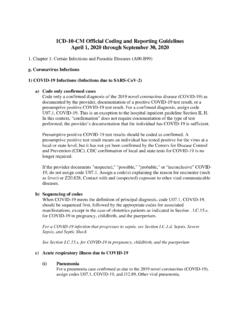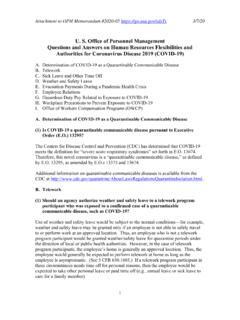Transcription of WHO guidelines on tuberculosis infection prevention and ...
1 WHO guidelines on tuberculosis infection prevention and control 2019 update WHO guidelines on tuberculosis infection prevention and control 2019 update WHO guidelines on tuberculosis infection prevention and control, 2019 update. ISBN 978-92-4-155051-2. World Health Organization 2019 . Some rights reserved. This work is available under the Creative Commons Attribution-NonCommercial-ShareAlike IGO. licence (CC BY-NC-SA IGO; ). Under the terms of this licence, you may copy, redistribute and adapt the work for noncommercial purposes, provided the work is appropriately cited, as indicated below. In any use of this work, there should be no suggestion that WHO endorses any specific organization, products or services. The use of the WHO logo is not permitted. If you adapt the work, then you must license your work under the same or equivalent Creative Commons licence. If you create a translation of this work, you should add the following disclaimer along with the suggested citation: This translation was not created by the World Health Organization (WHO).
2 WHO is not responsible for the content or accuracy of this translation. The original English edition shall be the binding and authentic edition . Any mediation relating to disputes arising under the licence shall be conducted in accordance with the mediation rules of the World Intellectual Property Organization. Suggested citation. WHO guidelines on tuberculosis infection prevention and control, 2019 update, Geneva: World Health Organization; 2019 . License: CC BY-NC-SA IGO. Cataloguing-in-Publication (CIP) data. CIP data are available at Sales, rights and licensing. To purchase WHO publications, see To submit requests for commercial use and queries on rights and licensing, see Third-party materials. If you wish to reuse material from this work that is attributed to a third party, such as tables, figures or images, it is your responsibility to determine whether permission is needed for that reuse and to obtain permission from the copyright holder.
3 The risk of claims resulting from infringement of any third-party-owned component in the work rests solely with the user. General disclaimers. The designations employed and the presentation of the material in this publication do not imply the expression of any opinion whatsoever on the part of WHO concerning the legal status of any country, territory, city or area or of its authorities, or concerning the delimitation of its frontiers or boundaries. Dotted and dashed lines on maps represent approximate border lines for which there may not yet be full agreement. The mention of specific companies or of certain manufacturers' products does not imply that they are endorsed or recommended by WHO in preference to others of a similar nature that are not mentioned. Errors and omissions excepted, the names of proprietary products are distinguished by initial capital letters. All reasonable precautions have been taken by WHO to verify the information contained in this publication.
4 However, the published material is being distributed without warranty of any kind, either expressed or implied. The responsibility for the interpretation and use of the material lies with the reader. In no event shall WHO be liable for damages arising from its use. Design by In s Communication WHO/CDS/ Contents Abbreviations iv Glossary v Acknowledgements xii Declarations of interest xiv How to use these guidelines xv Executive summary 1. Guideline development methods 2. Summary of recommendations 3. 1. Introduction 4. Scope of the guidelines 5. Objective 5. Target audience 5. 2 Recommendations 10. Administrative controls 10. Environmental controls 21. Respiratory protection 27. components of IPC programmes 29. 4. Methods 33. Preparation for evidence assessment 33. Evidence retrieval, quality assessment and grading of the evidence 34. Formulation of the recommendations 35. Guideline Development Group decision-making 35. Guideline preparation, peer-review and content presentation 35.
5 5. Research priorities 36. 6. Publication, dissemination and implementation 38. References 39. Annexes 45. Annex 1 List of participants to the Guideline Development Group meeting 45. Annex 2 Summary of declarations of interest and management 47. Annex 3 Risk of acquiring tuberculosis infection , progression to active disease and the effect of treatment on infectiousness 50. Online annexes Annex 4 GRADE evidence summary tables Annex 5 GRADE evidence-to-decision tables Annex 6 Results of the systematic reviews used to inform the development of these guidelines Online annexes can be accessed at: guidelines - tuberculosis - infection -preven tion- 2019 /en/. Abbreviations ACH air changes per hour AMR antimicrobial resistance CI confidence interval DOI declaration of interest DR-TB drug-resistant TB. DST drug-susceptibility testing GNI gross national income GRADE Grading of Recommendations Assessment, Development and Evaluation GUV germicidal ultraviolet light HAI health care-associated infection HEPA filter high-efficiency particulate air filter HIV human immunodeficiency virus IEC information, education and communication IGRA interferon-gamma release assay IPC infection prevention and control IRR incidence rate ratio LTBI latent tuberculosis infection M.
6 tuberculosis Mycobacterium tuberculosis MDR-TB multidrug-resistant TB. OR odds ratio PICO population, intervention, comparator and outcome SDG Sustainable Development Goal RR rate ratio TB tuberculosis TST tuberculin skin test USAID United States Agency for International Development UVC ultraviolet light C. UVGI ultraviolet germicidal irradiation WHO World Health Organization WHO guidelines on tuberculosis infection iv prevention and Control 2019 UPDATE. Glossary Term Description General Antimicrobial resistance The loss of effectiveness of any anti-infective medicine, including (AMR) antiviral, antifungal, antibacterial and antiparasitic medicines. Grading of Recommendations An approach to grading in health care that aims to overcome Assessment, Development the shortcomings of current grading systems. For further and Evaluation (GRADE) information, see the GRADE General hospital A health care institution providing medical or surgical (or both) treatment and nursing care for sick or injured people.
7 General population All individuals, without reference to any specific characteristic. Health care-associated An infection occurring in a patient during the process of infection (HAI) care in a hospital or other health care facility, which was not present or incubating at the time of admission. HAIs can also appear after discharge. They represent the most frequent adverse event associated with patient care. Health workers All people engaged in actions whose primary intent is to enhance health (as defined in Chapter 1 of The world health report 2006 working together for health2). Household contact of TB An individual who is residing or who had resided in the same patient household as the infectious TB patient. Infectiousness Probability of tuberculosis (TB) transmission from an individual with TB disease (usually pulmonary TB) to a susceptible individual through aerosols with droplet nuclei containing viable Mycobacterium tuberculosis while, for example, coughing, sneezing or talking.
8 Latent TB infection (LTBI) The number of new persons identified with LTBI within a incidence specified period of time. LTBI prevalence The number of persons identified with LTBI at a given point in time. Multimodal strategy Several elements or components (at least three, and usually five3) implemented in an integrated way, with the aim of improving an outcome and changing behaviour. Such a strategy includes tools ( bundles and checklists) developed by multidisciplinary teams that take into account local conditions. The five most common components are system change 1 See 2 Health workers, in: The world health report. Geneva: World Health Organization; 2006 ( , accessed 18 December 2018). 3 Evidence-based care bundles. Institute for Healthcare Improvement; ( , accessed 18 December 2018). Glossary v Term Description (availability of the appropriate infrastructure and supplies to enable infection prevention and control [IPC] good practices).
9 Education and training of health workers and key players ( managers); monitoring of infrastructure, practices, processes and outcomes, and provision of data feedback; reminders or communications in the workplace; and culture change within the establishment or strengthening of a safety TB incidence The number of new and recurrent (relapse) episodes of TB (all forms) occurring in a given TB prevalence The number of TB cases (all forms) at a given point in IPC interventions Hierarchy of infection TB prevention and control consists of a combination of prevention and control measures designed to minimize the risk of M. tuberculosis measures transmission within populations. A three-level hierarchy of controls comprising administrative controls, environmental controls and respiratory protection has been shown to reduce and prevent the risk of transmission and exposure to M. tuberculosis . Administrative controls Administrative controls are the first and most important level of the hierarchy.
10 These are management measures that are intended to reduce the risk of exposure to persons with infectious TB. Environmental controls The second level of the hierarchy is the use of environmental controls to prevent the spread of infectious droplet nuclei and reduce their concentration. Respiratory protection The third level of the hierarchy is the use of respiratory controls protection control. It consists of the use of personal protective equipment in situations that pose a high risk of exposure to M. tuberculosis . Mechanical ventilation Ventilation created using an air supply or an exhaust fan (or both), to force air into or out of a room. Mixed-mode ventilation A ventilation system that combines both mechanical and natural ventilation, providing the opportunity to choose the most appropriate ventilation mode based on the circumstances. 1 guidelines on core components of infection prevention and control programmes at the national and acute health care facility level.













